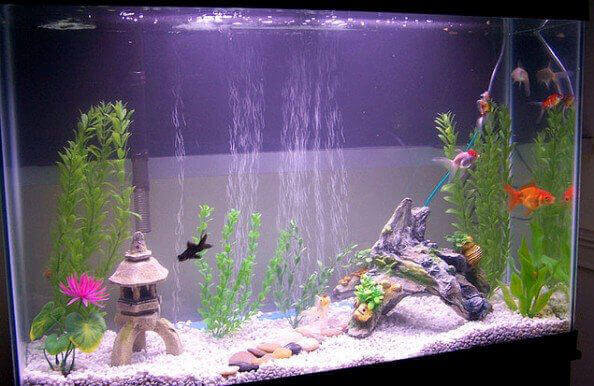Unexpected Victims of Heat Wave
I was in a sandwich shop getting lunch the other day when I noticed something wrong with the fish tank in the back. No bubbles! A powerful storm had downed trees four days earlier and knocked out power to 2 million people, but most businesses, including the sandwich shop, were open again. But the tank’s filter and aerator had stopped working, the water was murky and yellow, and the water level was down as a result of evaporation in the heat. I stared at the fish, and they stared at me. Fiddling with the equipment, even turning the breaker switches on and off, had no effect. It took a couple of hours to find a tropical-fish store that was open, get a new aerator and filter, and add about 20 gallons of filtered water to the tank, but at last, the fish stopped gasping.
There are many reasons not to keep fish in a tank, but in summer and winter, with increased storm activity, anyone with an aquarium needs to be prepared for a power outage. If you have an aquarium, assemble an emergency kit today—you may not be able to get what you need before or after the storm because stores may be closed or have run out of supplies. Even if you don’t have a tank, please read these tips so that you can share them with someone you know who keeps fish:
- Get a battery-operated air pump with extra batteries. Power companies are often unable to restore power for days, and each set of batteries lasts about 20 hours, so stock up. Stores sell out of these pumps fast when emergencies strike.
- A “UPS” or uninterrupted-power-supply battery keeps your aquarium operating for a few hours, which could be long enough for you to return home during a power outage. Keep one hooked up to your aquarium at all times.
- Pick up and store at least a couple of jumbo-size aquarium-use–approved filtered water bottles or get a tap-water filtering system suitable for aquariums, as you may need these to try to aerate the tank through water exchange.
- Keep Mylar blankets as well as heat packs in the house to wrap around the tank during a winter outage.
What to Do When the Power Goes Out
Make sure that the water is aerated. If you have not prepared by getting a battery-operated air pump, you may be able to save the fish by changing the water (do not introduce untreated tap water), or just remove some of the water from the tank and pour it back in again to introduce air.
During winter outages, wrap the tank in Mylar blankets and monitor the temperature. During summer outages, move the tank to a dark spot or otherwise shield it from direct light if possible, which reduces stress and heat. Check the temperature, and if it gets too warm, replace the water with slightly cooler water if you can.
Why Not to Keep Fish
Fish are smart, interesting individuals who naturally live in streams, rivers, and the ocean, not in a water-filled box that keeps them hovering in a diluted mixture of their own waste and rotting food. It’s like making your cat live inside a sealed, unchanged litterbox.
And what is there for them to do? In nature, they explore, have friends (yes, there are lots of studies about this), and enjoy the seasons, seeking a mate and raising young. In other words, they have a life. Thinking it’s OK to use them as cute decorations is to hold an archaic view of nature, as if it’s OK to dominate and use animals as a commodity rather than respecting them for their individuality and their right to live their own lives.


